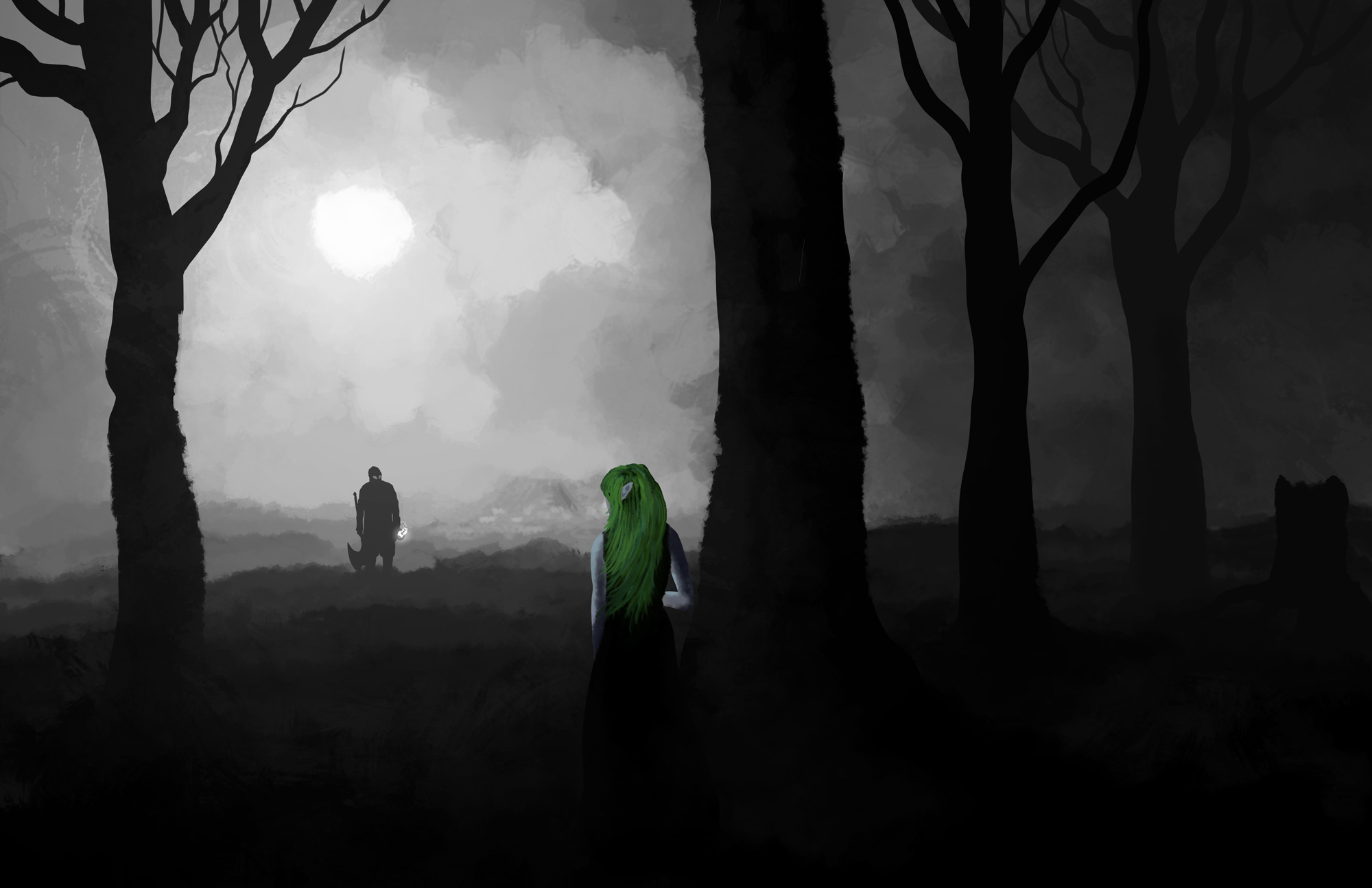Challenge Resolution
In Huldufolk, there are two basic challenge types; defended and undefended. Undefended challenges are most commonly environmental tests, situations where the task is difficult enough to require a pool, but the Actor is not actively being opposed by another character or force. Undefended challenges can most simply be understood as challenges in which only one party plays a card.
In defended challenges, on the other hand, multiple opposed parties play cards. Defended challenges are the primary resolution for most combat1Note there are situations in which attacks may be undefended. and for opposed situations in which multiple characters or groups compete for mutually-exclusive goals. Defended challenges between player characters may always be resolved by player-to-player mediation, which allows for narrative solutions which may not be easily replicated mechanically, and carries the additional benefit that neither player has to expend a card.
Mediation
The Huldufolk rules system is designed as a rules-light game. Compared to most tabletops, or even some LARPs, there are a small number of rules, and they are not intended to perfectly simulate reality. In any contested event, players are encouraged to first determine if they can mediate a mutually-acceptable result. Due to the built-in dwindling of resources in Huldufolk, attempting to solve every problem with brute-force mechanics is likely to cause a character to run dry very early in an event. If the two players cannot reach an agreement about the outcome of a challenge, they should then take the step of engaging in a mechanical challenge.
The Deck
All characters can be separated into either Major or Minor Actors, while there are a few major differences between them, the most essential is the type of deck each receives. At the beginning of a game, Major Actors receive a 10 card deck containing A-10 (known as a Full Deck) while Minor Actors receive a 5 card deck containing A-5 (known as a Half Deck). The current cards in a given player’s deck signify the amount of effort and energy they have in reserve. A player with a full deck is fresh, having either expended very little effort or taken a great deal of time to rest since their last exertion. A player with only three cards left is flagging, on the edge of their abilities. They may have exhausted their best options, or they may be carefully pacing themselves, with a couple of big plays still to make, that depends on the value of the cards still held in reserve.
A card is expended any time it is used in a test, either offensive or defensive. After the test is resolved, the player surrenders their card to the storyteller (or in some other way removes it from their deck) regardless of the result -a task requires just as much effort whether or not you succeeded or failed. The only exception to this test is the Ace card, which is never surrendered. Even at their most beaten-down, characters can at least attempt to take action, even if that attempt has only the slightest energy behind it.
Building the Pool
As mentioned above, both Defended and Undefended tests are accomplished by building a test pool and comparing the total to either the challenge rating or the opponent’s test pool.
Challenge Ratings:
- 5: A test rated as difficulty 5 is a basic task. For example, driving a car on a typical day. Characters who possess an appropriate affinity do not have to build a pool in order to accomplish tasks rated at 5 or below, these are simple matters of course.
- 6-12: A test rated between 6 and 12 is uncommonly difficult. At 6, the challenge may be driving a car through rush-hour traffic. At 12, the challenge could be driving through a blizzard, or driving at night without headlights on a back-country road.
- 13-17: A test rated between 13 and 17 is exceptionally difficult. At 13, the challenge might be driving through a hurricane or while missing a tire. At 17, the task is at the ultimate pinnacle of human capacity; driving in the Indy 500 while exchanging gunfire, or some similarly incredible feat.
- 18-30: A test rated at 18 is flatly impossible for a human being to accomplish. It requires either teamwork or (more likely) magical interference. A task rated at 25 is at the very upper-edge of the most accomplished Huldufolk player characters. A task rated at 30 is achievable only by the most accomplished Huldufolk with supernatural assistance.2See Lesser Paths: Service
- 30+: Here, there be dragons. A task rated above 30 is simply not something a player character can manage alone. It may be that they require direct assistance from other characters, or it may be that the task is simply beyond the ken of all but the Patrons.
A character’s pool consists of3Math for Nerds: This system is constructed such that a PC can have a maximum pool of 30 on a given test, if they have a Quality, a Focus, a powerful Artifact, and maxed supernatural bonuses (both personal and granted by the Service Lesser Path). With assistance, it is possible to go higher, to a theoretically infinite point. Most of the time, a character will hover around 10 in their specialty before the card is added, which is what the system is tuned to assume. A particularly capable Huldufolk might hang out in the 12-14 range.:
- Quality (If appropriate): +3
- Affinity Focus (If appropriate): +2
- Equipment: +0 – +2 (mundane) +0 – +5 (magical)
- Assistance: +1 (If assistant has the affinity) +3 (If assistant has the Focus) A character may be assisted by as many Actors as can logically take part in the action, per ST discretion
- Supernatural Bonuses: +0 – +10
- Card: +1 – +5 (Minor Actors) +1 – +10 (Major Actors)
The player adds all appropriate values together and determines their test pool, then surrenders the card to the storyteller, at which point the total pool is compared to their target number. In the case of undefended challenges, the card can be declared openly. In the case of defended challenges, all parties select their card before anyone announces their total pool.
Resisting Attacks
As discussed above, defended challenges are the resolution method for when two characters have mutually-exclusive goals. By far the most common example of this is when one character’s goal is “hit X person” and their target’s goal is “not get hit by Y person”. In Huldufolk, defense is a pool, but it is constructed slightly differently than most pools. Rather than being based on the combination of a Quality and affinity, defenses are based on a combination of a Quality and a Threshold, either mundane or supernatural.
All player characters start with a base mundane and supernatural threshold of 5, as do most Major Actors. Minor Actors can have a base threshold of anywhere between 0 and 5, depending on ST discretion and character type. Mundane Minor Actors (eg., regular humans, animals) always have a supernatural threshold of 0, while Minor Actors touched by magic (eg., supernatural beasts, particularly weak Huldufolk, empowered humans) may have a supernatural threshold of 0-5. Some Major Actors have base thresholds above 5, though these are rare. The most notable examples are Patrons (base threshold 20), whose supernatural and mundane defenses are impossible to breach for all but the most powerful Huldufolk, and even then usually after a great deal of effort and struggle.
Each time a character is forced to defend against an attack, the relevant threshold decreases by 1, a threshold is restored either by magic, or by resting for 10 minutes.
A character’s defensive pool consists of (Defenders win ties):
- Quality (If appropriate): +3
- Threshold: +0 – +5
- Equipment: +0 – +5
- Supernatural Bonuses: +0 – +10
- Card: +1 – +5 (Minor Actors) +1 – +10 (Major Actors)
A thorough example of defense can be found in Additional Mechanics.

